When companies get serious about sustainability, they get serious about the lifecycle analysis (or lifecycle assessment) of their products. The lifecycle assessment is a methodology that breaks down and quantifies the materials and energy used throughout the entire lifecycle of a product − from the actual extraction of raw materials to its final end-of-life. It is the established way of quantifying the environmental impacts of a given product.
For example, companies can use the lifecycle assessment to target the reduction of materials and energy used, which typically translates to savings in greenhouse gas emissions. The lifecycle assessment can also identify potentially toxic substances that can be replaced with better options, making the product safer to use and less problematic at end-of-life. It can also be used to identify heavier materials that can be replaced with lighter options that will translate to less energy and costs associated with transportation.
Lifecycle assessments aren’t new. During research for this blog the earliest example I could identify was attributed to the Coca-Cola Company in 1969. In thinking about a product like a traditional soft drink, one must consider not only what’s involved in growing the sugarcane, but also the water used, the energy and materials to create the packaging, and what happens to the container after the beverage is consumed.
When one thinks of electronics, one has to consider all the energy and materials consumed from their original sourcing (raw materials extraction), to all the resources and energy used during production of the product or device, to all the energy that will be consumed when the item is in use, and all the environmental implications of what happens at the end of its useful life.
Actual lifecycle assessments are not cheap and easy. The methodology is exacting. Yet it is the one way to determine the actual environmental impacts of a given product. You may not come across lifecycle assessments for the products you consume unless you go looking for them. At illumynt we are looking seriously at the lifecycle assessments of assets we process every day to help determine the importance and impact of extending their useful life.
Join me in my continuing blog series as I discuss all things related to sustainable electronics.




